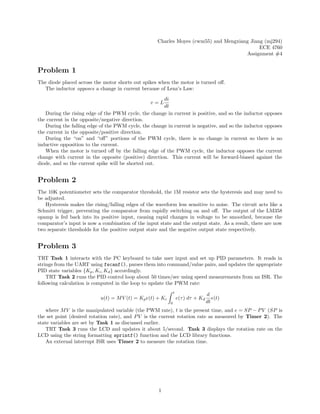
Ece4760 hw4
- 1. Charles Moyes (cwm55) and Mengxiang Jiang (mj294) ECE 4760 Assignment #4 Problem 1 The diode placed across the motor shorts out spikes when the motor is turned off. The inductor opposes a change in current because of Lenz’s Law: di v=L dt During the rising edge of the PWM cycle, the change in current is positive, and so the inductor opposes the current in the opposite/negative direction. During the falling edge of the PWM cycle, the change in current is negative, and so the inductor opposes the current in the opposite/positive direction. During the “on” and “off” portions of the PWM cycle, there is no change in current so there is no inductive opposition to the current. When the motor is turned off by the falling edge of the PWM cycle, the inductor opposes the current change with current in the opposite (positive) direction. This current will be forward-biased against the diode, and so the current spike will be shorted out. Problem 2 The 10K potentiometer sets the comparator threshold, the 1M resistor sets the hysteresis and may need to be adjusted. Hysteresis makes the rising/falling edges of the waveform less sensitive to noise. The circuit acts like a Schmitt trigger, preventing the comparator from rapidly switching on and off. The output of the LM358 opamp is fed back into its positive input, causing rapid changes in voltage to be smoothed, because the comparator’s input is now a combination of the input state and the output state. As a result, there are now two separate thresholds for the positive output state and the negative output state respectively. Problem 3 TRT Task 1 interacts with the PC keyboard to take user input and set up PID parameters. It reads in strings from the UART using fscanf(), parses them into command/value pairs, and updates the appropriate PID state variables {Kp , Ki , Kd } accordingly. TRT Task 2 runs the PID control loop about 50 times/sec using speed measurements from an ISR. The following calculation is computed in the loop to update the PWM rate: t d u(t) = M V (t) = Kp e(t) + Ki e(τ ) dτ + Kd e(t) 0 dt where M V is the manipulated variable (the PWM rate), t is the present time, and e = SP − P V (SP is the set point (desired rotation rate), and P V is the current rotation rate as measured by Timer 2). The state variables are set by Task 1 as discussed earlier. TRT Task 3 runs the LCD and updates it about 5/second. Task 3 displays the rotation rate on the LCD using the string formatting sprintf() function and the LCD library functions. An external interrupt ISR uses Timer 2 to measure the rotation time. 1
- 2. Problem 4 Shared variables between each task include the PID parameters (which may be changed by the keyboard task Task 1, along with the rotation rate, which is gathered from the Timer 2 ISR and read by the LCD task Task 3 and the PID controller task Task 2. The PID parameters include the proportional gain Kp , the integral gain Ki , and the derivative gain Kd . Problem 5 The period for a motor rotation at 1000 RPM is: 60 ≈ 0.06 seconds 1000 Therefore, we need the timer to not overflow within 0.06 seconds. Running at full rate, Timer 2 has an overflow period of: 216 = 0.004 seconds 16000000 Solving for the minimum clock divider needed to maintain this rate gives: 216 · x = 0.06 seconds ⇒ x 14.65 16000000 This tells us that a clock divider of 32 should suffice for Timer 2 to measure rotations at this rate. 2
